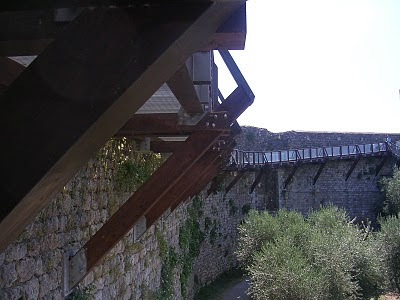Somehow Monteriggioni had escaped my notice until about two years ago. It is near San Gimignano, which is so well-known among Italian, and especially Tuscan, visitors, that I suppose it has just escaped the media machine, largely.
But our friends who grew up in the area insisted two years ago that I should visit it when possible, so this time, with other friends, I did.
According to what I read (on Wikipedia), the fortress city was built in 1213 by the Sienese, as a lookout and base of operations in defending themselves against the Florentines, who wanted to enlarge their territory.
The Wikipedia article states, "Except for some work done in the late 15th century, very little has been done to Monteriggioni's walls or buildings since they were first erected. Monteriggioni's walls and the buildings that make up the town within are the best preserved example of their kind in all of Italy, attracting tourists, architects, medieval historians and archaeologists. The town appears to float above the valley at night due to the hillside walls and towers being lit from below with light."
Well, I would love to see that nighttime view, but it will have to wait until another visit. If it's waited this long, I suppose another couple or few years won't increase the risk of the city disappearing. Meanwhile, I have happy memories of our daytime visit.
 Looking up at the city walls from the parking lot.
Looking up at the city walls from the parking lot.
Proof that I was there.
 With my friends.
With my friends. Despite what the Wikipedia article said, I'm thinking the walkways were probably added later than the late 15th century. It's really nice how they did this, so you can walk around part of the walls--though you're not allowed to walk on the walls, as I suppose soldiers would have done centuries ago.
Despite what the Wikipedia article said, I'm thinking the walkways were probably added later than the late 15th century. It's really nice how they did this, so you can walk around part of the walls--though you're not allowed to walk on the walls, as I suppose soldiers would have done centuries ago. I love the way plants grow anywhere they can! (As long as it's not where I don't want them.) I learned on this trip that these are the plants from which we get capers.
I love the way plants grow anywhere they can! (As long as it's not where I don't want them.) I learned on this trip that these are the plants from which we get capers. The back of the church, seen from atop the wall.
The back of the church, seen from atop the wall. The front of the church, seen from the city square.
The front of the church, seen from the city square. The colored stone used in the church is just beautiful! I don't recall ever seeing such stone anywhere else.
The colored stone used in the church is just beautiful! I don't recall ever seeing such stone anywhere else.I was intrigued and encouraged by a sign inside the church that read, essentially and in Italian, "We may be a small church in a very small town, but we are 42 active Christians who worship God here, and we welcome you to our church." I also saw information about that tiny church helping support mission work in Tanzania. It's not simply a museum in a tourist town.
 Ah, Italy!
Ah, Italy! Standing at the bottom of one of the city's two streets. Walking the street and coming upon this view was breathtaking.
Standing at the bottom of one of the city's two streets. Walking the street and coming upon this view was breathtaking.
2 comments:
That stone just looks like a watercolour, what a beautiful place.
I think you'd be the ideal person to visit Italy with. I'd so love to do so but always thought I'd like to be with someone who knew and loved it well and could speak the language.
Now I'm a little worried that caper-gatherers have to risk their necks scaling precipitous walls just so I can have my tartar sauce...
Well, maybe one of these days we could combine tours of Italy and France, because I think it'd be much more fun to visit France if I were with someone who spoke the language!
I was really surprised at the caper plants! I'm assuming they also grow in easier-to-reach places for an industry to have been built around them, but then again, they are generally found in very small jars....
Post a Comment